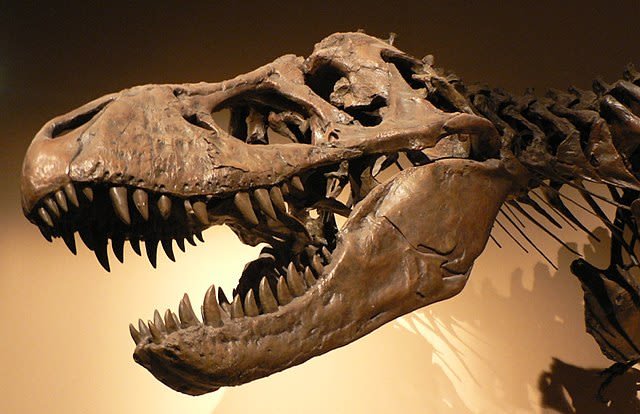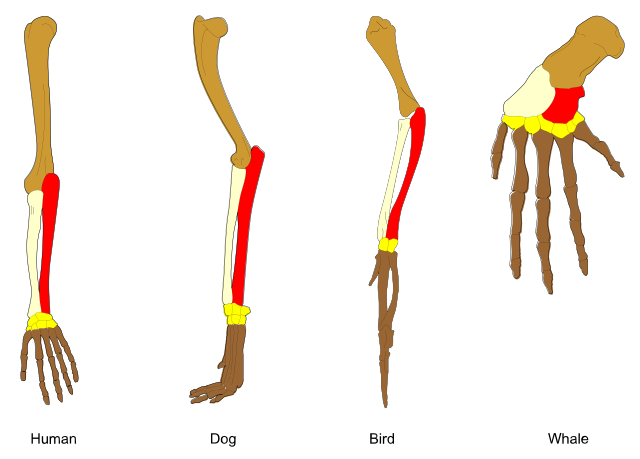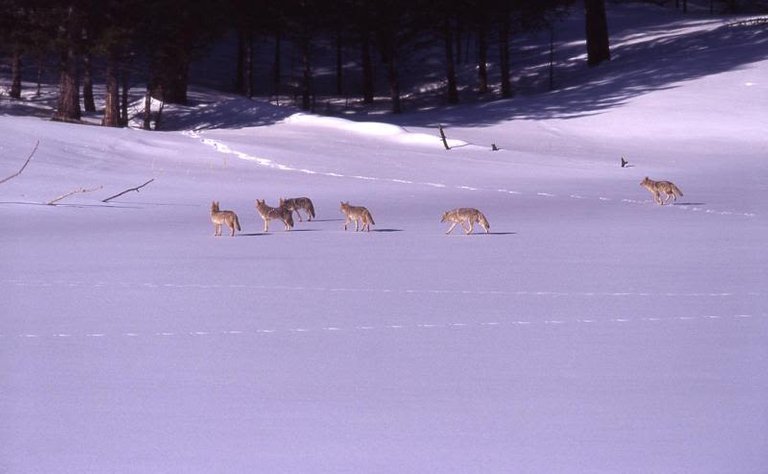Many people tend to think that evolution is
something that happened in the past and that the world of today is the finished
product. But this is far from the truth: evolutionary forces are still at work
and natural selection is continually changing the characteristics of
populations, often with great speed. Consider the following examples:
- The widespread use of antibiotics such as penicillin rapidly led to the development of resistant strains of bacteria. Penicillin works by inhibiting one of the enzymes that the bacteria need in order to manufacture cell walls. However, many resistant strains can make an enzyme, penicillinase, that breaks down the antibiotic.
- The use of warfarin as a rat poison has led to the development of warfarin-resistant rats. Warfarin is an anti-coagulant that kills rats by inducing haemorrhage (internal bleeding). Resistant rats have a modified enzyme in their blood-clotting system that allows their blood to clot in the presence of warfarin.
- Copper tolerance in the grass Agrostis tenuis. Copper is a metabolic poison that prevents many plants from growing on copper-polluted land. However, resistant plants have evolved. These can transport copper out of their cells, so that it accumulates in the cell wall and does not interfere with the plant’s metabolism. (In non-polluted areas, the normal type of grass out-competes the copper-resistant strain.)
The organisms in these examples have a short life cycle and high reproductive capacity, and so can respond quickly to the selection pressure placed on them. The effects of selection pressure on organisms that live longer and have a lower reproductive capacity take much longer to become apparent.

DIFFERENT TYPES OF NATURAL SELECTION
From what you have learned about natural selection, it would be tempting to assume that it is just a mechanism for change. However, this is not always the case: it can be a means of keeping things static. Many organisms, crocodiles and sharks for example, have not changed significantly for millions of years.
There are basically three different types of natural selection:
- Stabilizing selection: In a favourable and unchanging environment, stabilizing selection can lead to a ‘standardizing’ of organisms by selecting against the extremes. An example of this is human birth weight. Studies show that particularly large or small babies have a higher mortality than those in the mid-range.
- Directional selection: This mechanism tends to occur following some kind of environmental change that causes selection pressure. The organisms with a particular extreme of phenotype may have an advantage. At some stage, directional selection must have operated to produce the long neck of the giraffe. Probably, in times of food shortage, only the tallest individuals could reach enough food to survive and pass on their genes to the next generation.
- Disruptive selection: This type of selection acts at both ends of the distribution, favouring individuals with extreme rather than average characteristics. Rarer than the other two types, disruptive selection is important in the formation of new species, where natural selection acts differently on different populations. An example of this is seen in Darwin’s finches where disruptive selection has acted on beak size. In some situations, those with longer, thinner beaks would have succeeded in exploiting insects as a food source, while those with shorter. stronger beaks would have succeeded in cracking seeds. Those with average beaks were adapted for nothing in particular and would have reproduced less successfully.

These charts depict the different types of genetic selection. Ealbert17, CC BY-SA 4.0
Artificial selection
Humans have practiced artificial selection, or selective breeding, for thousands of years. We haven’t needed a scientific understanding of genetics to do this: animals or plants with the most desirable features are simply crossed or mated. For example, if cows with the highest milk yield are impregnated by the healthiest and fastest-growing bulls, many of the next generation are big, healthy cows that produce large quantities of milk. Those that do not have the desired features are not used for breeding. In this way, artificial selection rather than natural selection is used to bring about great changes in the phenotype in a short time: animals and plants can be ‘domesticated’ in just a few generations.
Selective breeding is still important in many different areas of food production in increasing the growth rate and the meat, milk or egg production of livestock; in increasing the disease resistance of crop plants (increasing the disease resistance of animals by selective breeding is not as reliable); in changing the muscle to fat ratio of livestock, so that more lean meat is produced; in increasing the yield and nutritive value of crop plants such as wheat; and finally, in Increasing the tolerance of plants and animals to drought, heat or pollutants.
THE EVIDENCE FOR EVOLUTION
Today, there are few scientists who seriously doubt the theory of evolution, or that it happens by natural selection. Here we consider some lines of evidence.
FOSSILS
Palaeontology, the study of fossils, supports the theory of evolution. Most fossils are found in sedimentary rocks, formed by layers of silt that preserve the bodies of organisms before they have a chance to decay in the normal way. In many places it is clear that different layers, or strata represent different time periods. By studying the fossils in these strata, we find obvious evidence for the gradual evolution of some species.
GEOGRAPHICAL DISTRIBUTION
A study of the distribution of species presents strong evidence that organisms evolved ‘into’ their ecosystem rather than being placed there during a single act of creation. During his time in South America, Darwin encountered a classic piece of evidence for evolution. On the South American mainland, finches have short, straight beaks to crush seeds. Other species have taken advantage of the other food sources. On the Galapagos Islands, however, things are different. One way or another, the finches managed to get to the islands, while many other species of birds did not. In the absence of competition, the finches have evolved to take advantage of the range of food sources on offer. Woodpecker finches, for instance, have long beaks for extracting insects from holes in trees.
Evolution on islands
Darwin found out on his voyage, islands are particularly interesting places to study evolution. Young, volcanic islands such as the Galapagos are often colonized by plants whose seeds have been blown there by the wind, and by flying animals which have been driven off course by storms. In later years, of course, colonization by non-flying animals (such as rats and cats) is likely to be a result of human activity.
The evolution of birds on islands can be very spectacular. Free from predators, birds often lose the power of flight and sometimes grow very large. Before the Maori settlers arrived from Polynesia, New Zealand was a bird-dominated ecosystem. Huge flightless birds, moas, some as tall as 3.5 metres, evolved to fill the niches normally occupied by mammals. They were easy prey for the Maoris, however, who hunted them to extinction within a few centuries. Ironically, the only survivor of the moa family, the kiwi, has become the country’s national emblem.

Topographic and bathymetric map of the Galápagos Islands, Ecuador. Eric Gaba, CC BY-SA 3.0
COMPARATIVE ANATOMY
The anatomy (body plan) of plants and animals can reveal a lot about evolutionary relationships. The figure below shows one of the classic examples of comparative anatomy, the pentadactyl limb (five-fingered limb). This structure appears in various forms throughout the vertebrates: the feet of reptiles and amphibians, the human arm, the bat’s wing. The seal’s flipper, for example.
This basic five-fingered plan has been modified in a variety of ways to suit the animal’s mode of locomotion. Structures with a common origin but with a different function are said to be homologous. So, the wing of a bat is homologous to a human hand. The possession of the pentadactyl limb in so many different organisms is persuasive evidence that these animals have evolved from a common ancestor.
In contrast, totally unrelated structures can become adapted for the same function. The wings of insects and the wings of birds, for example, have a totally different anatomy and origin in the embryo, but are similar in shape because they perform the same job. Such structures are said to be analogous.
The process by which unrelated species evolve to resemble each other is called convergent evolution. A classic example of this is seen in seals (mammals), penguins (birds) and fish. Because of their need to swim efficiently, all have evolved the same streamlined shape. The forelimbs of the seal and the wings of the penguin have both evolved to resemble fins.

EMBRYOLOGY
Studying the development of an embryo reveals some interesting evolutionary secrets. The scientist Ernst Haeckl said ‘ontogeny recapitulates phylogeny’ which means that the evolutionary development of a species (its phylogeny) is mirrored by the changes of each individual from birth to maturity (its ontogeny).
A number of vertebrate embryos follow a very similar path from fertilization through several stages of early development – so similar that it is often difficult to tell them apart. For example, all vertebrate embryos develop branchial arches: these are relics of the gills possessed by aquatic ancestors. However, although the study of the developing embryo provides further evidence for evolution, it does not give us much information about the actual evolutionary process.
COMPARATIVE BIOCHEMISTRY AND BEYOND
Many animal genomes have been completely sequenced in the last few years and more are published all the time. Scientists are now able to compare organisms at the gene sequence level and gain new information about evolution. The science of comparative genomics looks at the similarities and differences between the sequences of corresponding genes to show how closely related two species are. There are also several online databases that enable researchers to add their data about the protein structure of individual proteins from different animal species. This is called comparative proteomics and it aims to look for the minor differences between highly conserved protein molecules to, again, help map out the evolutionary relationships between different species.
Like humans, individual animals also have a unique genetic fingerprint and this can be used to compare animals from the same species. Analysis of genetic fingerprints looks for subtle differences in genes, which are similar but not identical between different individuals. For example, one research project is tracking populations of snow leopards in Central Asia. Researchers set ‘hair snares’ to collect hair samples from the leopards that pass by and then analyse the DNA from the hairs. By comparing the profiles they get, they can tell how many different leopards are in the same area. They can even plot family trees, showing how related leopards move from one area to another. This is helping researchers to maximize their conservation efforts.
FINALLY, HOW DOES A NEW SPECIES EVOLVE?
We have looked at natural selection and seen that it can lead to stability or change. In this paragraph, I will examine how natural selection can lead to the formation of a new species.
WHAT IS A SPECIES?
We instinctively think that we know what the word ‘species’ means, but an accurate definition is difficult, if not impossible. This is a common definition: A species is a population or group of populations of similar organisms that are able to interbreed and produce fertile offspring.
This would seem to be reasonable; a horse and a donkey can mate to produce a mule, which is sterile, so the horse and the donkey can be said to belong to different species. However, this definition runs into trouble. There are many closely related species, wolves, coyotes and domestic dogs, for example, which can interbreed to produce perfectly fertile offspring. The only reason why the wolves and coyotes remain distinct is that the hybrids do not compete as successfully as the pure strains.
The difficulty in defining the term species stems from the very nature of the process of evolution. New species evolve from pre-existing ones, and this is usually a slow transition which may take many generations and thousands of years. There are many living species that are still in the process of separating from each other. The wolf and the coyote almost certainly evolved from a common ancestor and for all practical purposes are separate species. If left to evolve naturally over the next few thousand years, the two species may well accumulate enough genetic differences to prevent interbreeding. So, the definition can be modified to:
A species is a collection of recognizable organisms which shares a unique evolutionary history and is held together by cohesive forces of reproduction, development and ecology.
Although more of a mouthful, it is a more satisfactory description because it recognizes that all members of a species are usually (but not always) recognizable, and that they share the same 'biology', occupying the same niche in the ecosystem and having particular social structures, courtship, mating habits, etc.

A pack of coyotes in Yellowstone National Park. National Park Service, Public Domain
THE DEVELOPMENT OF NEW SPECIES
Speciation, the development of new species, happens when different populations of the same species evolve along different lines. It is thought that speciation usually happens in the following way:
- Part of a population becomes isolated in some way that prevents them from breeding with the rest of the population. Very often, the breakaway population will, by chance, have a different genetic constitution from the original.
- The two populations experience different environmental conditions, so that natural selection acts in different ways, causing the genetic make-up of the two populations to differ.
- Eventually, genetic differences accumulate to a point where individuals from separate populations that come together again can no longer interbreed. It is worth mentioning that new species can also arise from a hybridization between two different species. This particularly applies to plants, and plant breeders take advantage of this ability to produce new crop varieties.
There are two basic methods of speciation:
- Allopatric speciation (allo = different, patris = country), where the two populations are physically separated.
- Sympatric speciation, where the two populations are reproductively isolated in the same environment.
How populations become isolated
Usually, species evolve when populations become isolated by physical barriers such as stretches of water or mountain ranges. This is known as geographical isolation. Evidence suggests that geographical isolation is the most common way in which populations become reproductively separated. However, speciation can happen even when two populations overlap. For instance, two populations of frogs may have a different mating call, and the females may respond only to calls of males in 'their' population.
A Summary of Isolating Mechanisms and How it Works
In prezygotic mechanisms, i.e zygotes don’t come into contact.
- Geographic: two populations do not come into contact due to some physical barrier e.g. mountain range, water.
- Temporal: different timing, e.g. flowering times or mating seasons don not coincide.
- Behavioural: individuals of other populations are not acceptable as mates, e.g. wrong courtship, mating call or pheromones.
- Mechanical: structural differences prevent mating, e.g. the shapes of the genitals in the insects.
In postzygotic mechanisms, i.e. even if mating takes place
- Hybrid non-availabilty: hybrid zygotes fail to develop to sexual maturity.
- Hybrid sterility: hybrids do not produce functional gametes.
- Hybrid weakness: hybrids have reduced survival or reproductive rates.
Thanks for reading
REFERENCES
https://courses.lumenlearning.com/suny-wmopen-biology1/chapter/outcome-evidence-for-evolution/
https://www.livescience.com/474-controversy-evolution-works.html
https://courses.lumenlearning.com/boundless-biology/chapter/adaptive-evolution/
http://bivalves.teacherfriendlyguide.org/index.php?option=com_content&view=article&id=42&Itemid=124
https://www.sparknotes.com/biology/evolution/naturalselection/section1/
https://www.learner.org/courses/essential/life/session5/closer1.html
https://www2.palomar.edu/anthro/evolve/evolve_3.htm
https://en.wikipedia.org/wiki/Evidence_of_common_descent
https://www.britannica.com/science/paleontology
https://en.wikipedia.org/wiki/Paleontology
https://www.nature.com/subjects/palaeontology
https://www.sciencedirect.com/topics/earth-and-planetary-sciences/geographic-distribution
https://www.merriam-webster.com/dictionary/geographical%20distribution
https://journals.plos.org/plosbiology/article?id=10.1371/journal.pbio.0040334
Hello,
Your post has been manually curated by a @stem.curate curator.
We are dedicated to supporting great content, like yours on the STEMGeeks tribe.
If you like what we are doing, please show your support as well by following our Steem Auto curation trail.
Please join us on discord.
Really excellent overview! I'm finishing a class on evolutionary biology this week and have had to write at-length about each of these topics over the past 15 weeks. I particularly enjoyed discussing the processes of speciation, adaptive radiation, and paleontology's role in providing evidence supporting evolution.
Thanks for coming by,@passerine.
I'll be looking forward to read your articles on speciation and also on the role of paleontology in supporting evolution.
This post has been voted on by the SteemSTEM curation team
and voting trail. It is elligible for support from @curie and @minnowbooster.
If you appreciate the work we are doing, then consider supporting our witness @stem.witness. Additional witness support to the curie witness would be appreciated as well.
For additional information please join us on the SteemSTEM discord and to get to know the rest of the community!
Thanks for having used the steemstem.io app and included @steemstem in the list of beneficiaries of this post. This granted you a stronger support from SteemSTEM.